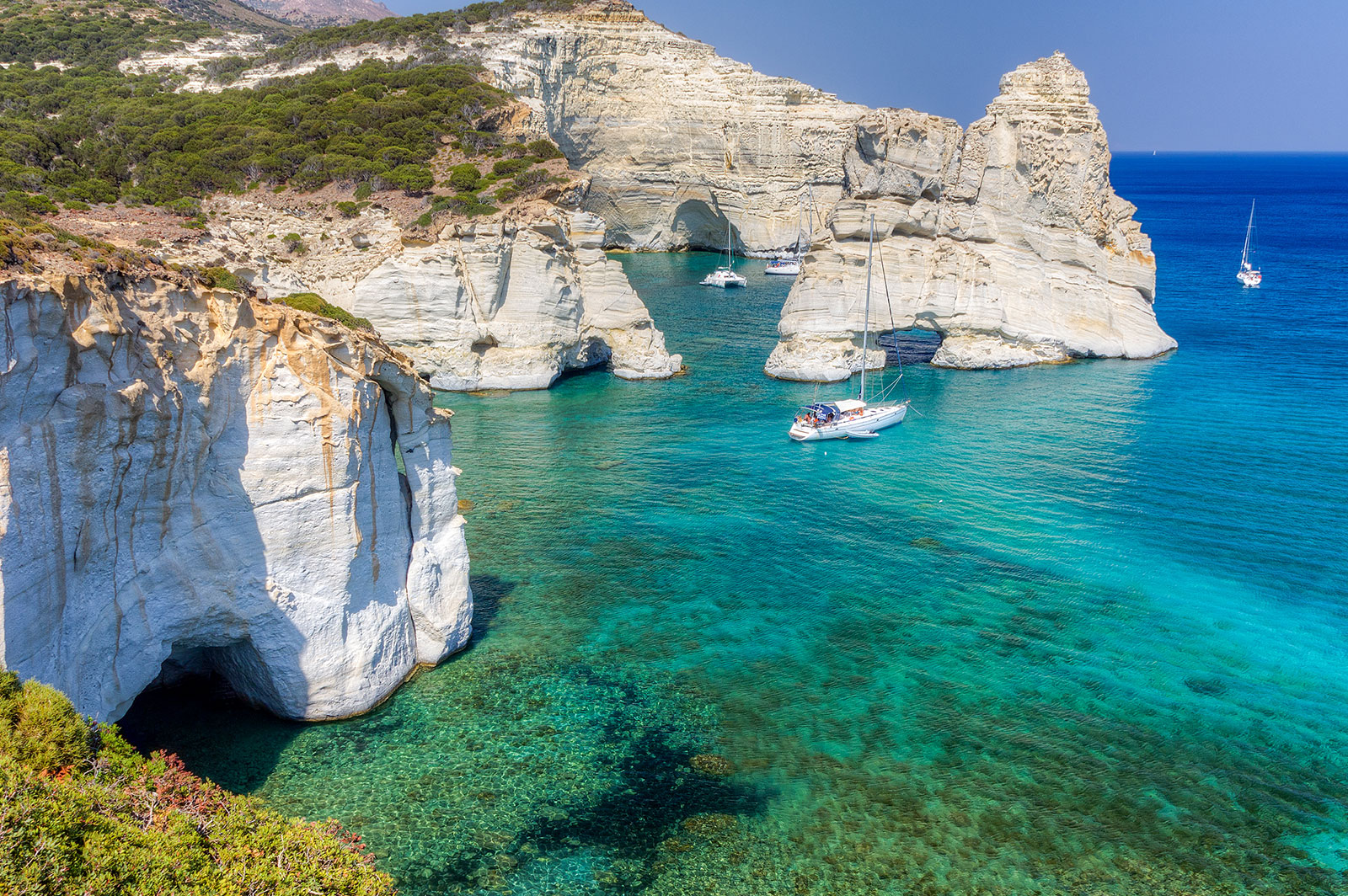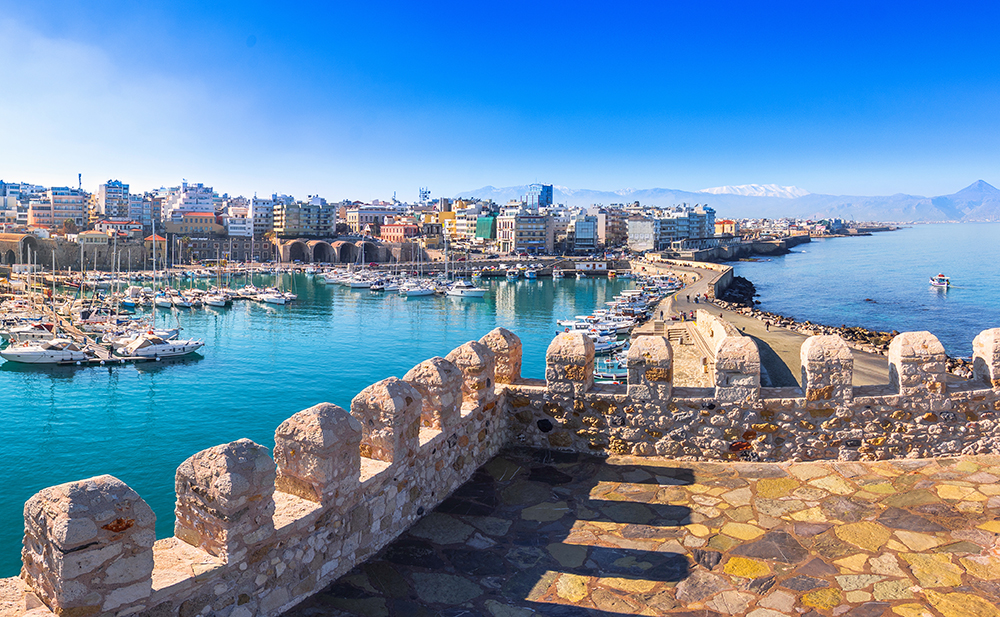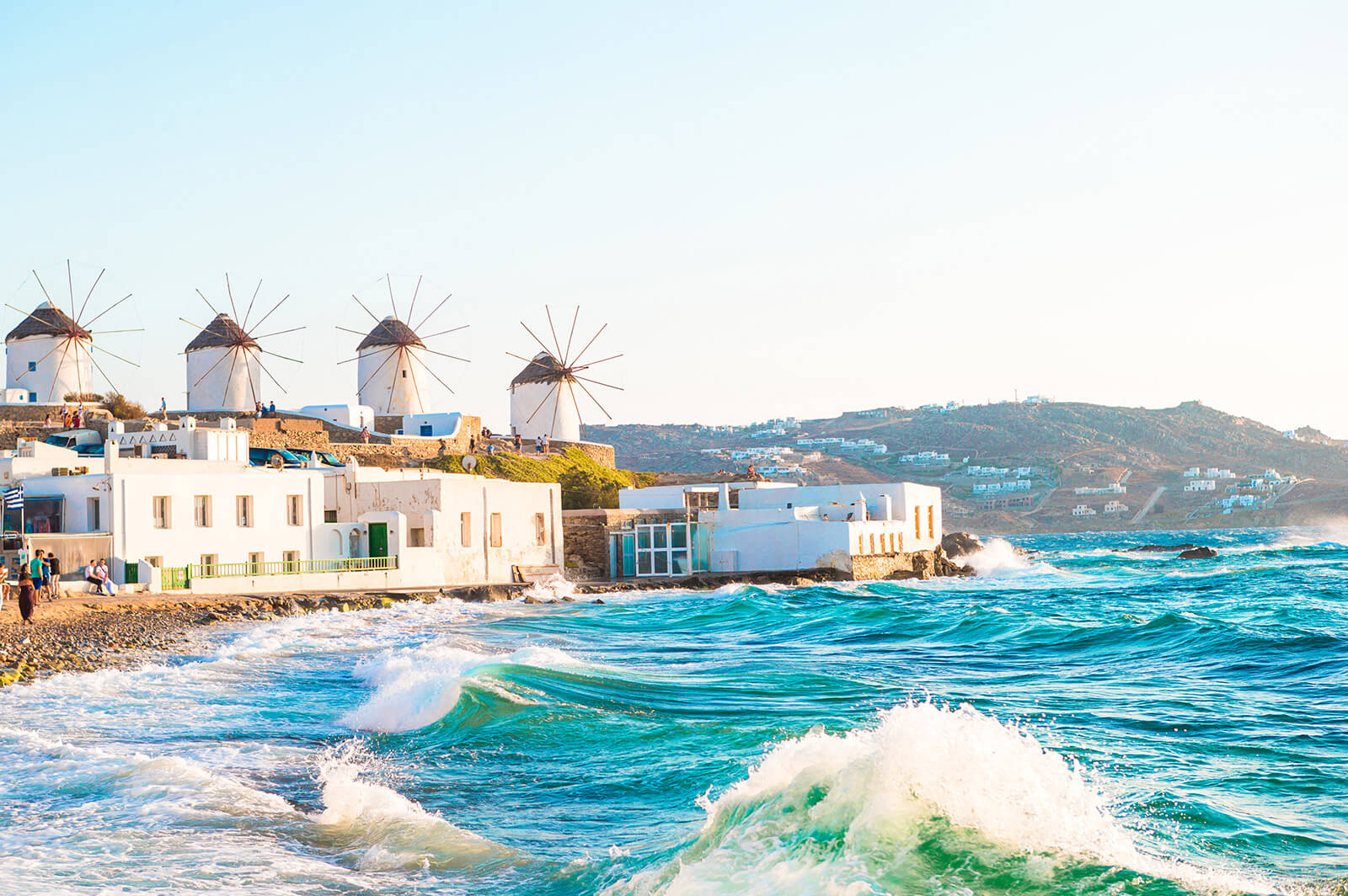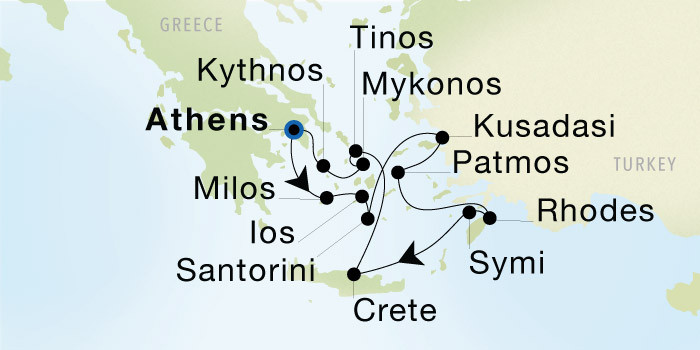
Piraeus, roughly translating to “the place over the passage”, is an important Greek port located within the Athens agglomeration, in the Attica Basin. It is 12 kilometers from the municipality of Athens, considered the fourth largest and is the third most populous amongst all the municipalities of Greece. Now a peninsula, Piraeus, originally a rocky island, was developed in early 5th Century B.C. when it was initially designated as Athens’ import and transit trade port. It is the largest marine-based shipping center of Greece, one of the largest ports in Europe, and considered the second largest passenger port in the world. Inhabited since the 26th Century, it wasn’t until the 6th Century B.C. that Piraeus began catching attention. The land of Piraeus was essentially impassable, flooded by the sea most of the year until centuries passed and the flooding ceased. By the 5th Century B.C. it became a navy base for the Athenian fleet for the natural harbors and the strategic potential they carried. Athenian general and politician Themistocles fortified Piraeus’ three harbors Kantharos, Zea and Munichia, created ship houses and completed his walls in 471 B.C., which led to the port becoming a great military and commercial harbor. There are many archaeological sites, points of interest and entertainment available in Piraeus. Most famous for its tavernas and cuisine, several popular events take place in Piraeus, such as the Ecocinema International Film Festival, the Maritime Festival, the Piraeus Rock Wave Festival and the Three Kings’ Way Festival. There are also many theaters, including the Municipal Theater, the open air Veakeio Theater, and the Menandreio Theater. Museums in Piraeus include the Archaeological Museum of Piraeus, the Merchant Shipping History Institute Exhibition, the Panos Aravantinos Decor Museum, the Georgios Averof Museum Ship and the Museum of Electric Railways. Be sure to catch the panoramic views available from the hill of Kastella, overlooking Athens and the Saronic Gulf!

Perhaps providing the most diverse and dramatic coastline of all the Greek islands, sheltered, horseshoe-shaped Milos boasts more than 70 beaches and is heralded as the location where Venus de Milo (the ancient Greek goddess Aphrodite) was discovered. Milos has been named “the island of colors” thanks to its volcanic origin, which offers beaches and waters with a variety of colors and distinct beauty. Due to the volcanic origin of its ground, Milos presents an impressive coastal morphology and diversity. There are white-yellow beaches, bays with pebbles surrounded by stones, and white, red, yellow or black rocks. While discovering your favorite sand upon which to relax, don’t overlook Sarakiniko’s volcanic white cliffs and Papafragas’s emerald-green swimming holes and caves—shaped by the island’s unique minerals, including obsidian, barite, and sulphur, which happily bubble up in abundant hot springs.

A Greek island in the Cyclades group in the Aegean Sea, Ios lies halfway between Naxos and Santorini. A hilly island with cliffs down to the sea on most sides, Ios shines for its amazing beaches, shimmering waters, and picturesque clifftop villages with narrow alleyways. Assessable by ferry or yacht, Ios is within hand’s reach of several Greek islands, including Mykonos, Naxos, Paros, and Crete. Ancient sites, museums, windmills, and churches dot the island, most notably the whitewashed church of Panagia Gremiotissa above Chora, the tomb of the Greek poet Homer in Plakoto, and the early Bronze Age settlement of Sharkos. The Archaeological Museum of Ios, displaying findings unearthed on the island, is housed in the Amiradakio Hall, located in the center of Chora.

Santorini, officially named Thira, is the southernmost Greek island that is within the Cyclades archipelago, in the southern Aegean Sea. Part of the regional unit Thira, the municipality of Santorini is comprised of the island Santorini, Therasia, and other uninhabited islands of Christiana, Palaia Kameni, Aspronisi, and Nea Kameni. The geological history of Santorini is quite complex due to the area’s volcanism and is currently a water-filled caldera: a rectangular lagoon that is surrounded by three steep cliffs. The name Santorini is a contraction of the name Santa Irini, which is based on an ancient cathedral found in the island’s village of Perissa. This name was given by the Latin Empire in the 13th Century. During the Ottoman Empire, Santorini was called “Santurin” or “Santoron”, and in early times, it was named Kalliste, Strongyle, and Thera. Santorini is the site of the Minoan Eruption (also known as the Thera Eruption), one of the largest eruptions ever in recorded history. The origins of Plato’s story of Atlantis is believed to have a connection to this eruption that destroyed the early settlements on what was formerly a single island. The descriptions found of Plato’s Atlantis strongly resembles Thera, and with seismological, archaeological, and volcanological evidence, these claims are further supported. There is also speculation that the eruption is related to the Exodus of the Israelites, as well as causing the plagues described in the Bible in ancient Egypt. The economy is sustained by two principal industries: tourism and agriculture, and has recently been voted as one of the world’s most beautiful islands in various outlets such as the Traveler’s Choice Awards in 2015. The wine industry in Santorini is becoming more relevant as well, made up of Assyrtiko, Athiri and Aidani grape varieties, which is best exemplified in Vinsanto (“holy wine”) which contains all three Aegean varietals. Although Santorini is highly arid, it’s unique ecology and climate allows it to grow unique and prized produce, such as cherry tomatoes, Lathyrus clymenum (a legume), and capers. Thus, tourists indulge in local specialties such as Brantada, Fava, and the traditional dish Santorinio Sfougato.

Kusadasi is a beach resort town on Turkey’s Aegean coast and the center of the seaside district of the same name in Aydin Province. The seaside town is also your gateway to the classical ruins at nearby Ephesus, among the world’s best preserved ancient Greco-Roman remains, including its excavated Terrace Houses and House of the Virgin Mary. Kusadasi’s seafront promenade, marina, and harbor are lined with quaint restaurants. Just offshore on Pigeon Island stands a walled thirteenth-century Byzantine castle that once guarded the town. Meet resident wild boars at nearby Dikek National Park, comprised of four secluded beaches, a spectacular coastline, and incomparable views of the Aegean Sea, just one of Turkey’s many protected conservation areas.

Patmos is in the South Aegean Islands, particularly a member of the Dodecanese Islands of Greece. It is north of Leros and is most known for its connection to John the Apostle from the Book of Revelations; therefore Christian pilgrims frequent this destination. In mythology, Patmos was named “Letois”, which is another named for the goddess Diana, Leto’s daughter. Since ancient authors seldom mention Patmos in early text, information on early inhabitants is limited. It is widely believed the original people of Patmos were the Carians from Asia Minor, as discovered by the earliest archaeological findings date back to the Bronze and Mycenaean periods. The mountain in the country of Caria was named Latmos, which is where historians believe the name Patmos is derived from. Dorians also colonized in Patmos, and over time, Ionians followed suit. The primary port in Patmos is Skala, which was one of the most important sea ports in the Mediterranean around the 16th century. Early Christian basilicas were constructed in the name of John of Patmos, however between the 7th and 9th century when Saracen attacks were still problematic, the Grand Royal Basilica was destroyed. A monastery began construction in 1101 when Christodoulos assumed authority over Patmos. The population began expanding as immigrants from the fall of Constantinople and Candia to place in the 15th and 17th centuries, respectively. The island was under the Ottoman rule for years and was interrupted by Venice during the Candian War, Russia during the Orlov Revolt, and Greece during their War of Independence. During the Italo-Turkish War, Italy occupied Patmos until 1943, when Nazi Germany held power over the island until 1945. Since Patmos rejoined in 1948, it has become the tranquil and frequented destination it is now. Tourists visit the Monastery of St. John, Chora, the Cave of Apocalypse, Psili Ammos Beach and other beautiful points of interest in “Europe’s most idyllic place to live,” as named by Forbes in 2009.

In ancient times, Lindos was the main hub on Rhodes. Homer tells us that it was established by the Dorians in the 12th century BC and that the city was large and powerful enough to send nine ships to the Trojan War. Towering above the village of Lindos is the ancient Acropolis. A 13th-century Crusader fortress now crowns the hill, but within its walls lie archaeological sites that date back to the 6th century BC. As you disembark from the yacht, prepare to journey through time as you explore the ancient marvels of this Greek town, a revered archaeological site steeped in history. Navigate the narrow cobblestone streets that wind their way to the base of the ancient Acropolis. Ascend the steep path and be rewarded with breathtaking views of the Doric Temple of Lindian Athena, nestled within the walls of a Crusader-era castle. From this vantage point, soak in panoramic vistas of the village, the shimmering sea, and the quaint fishing harbor of Psarto.

Symi is one of the most picturesque islands in the Dodecanese group. The backdrop of mountains that descend steeply into the sea forming beautiful bays such as Chorio takes one’s breath away. Stroll the quaint town, where every corner boasts a view of the Aegean Sea. Experience the timeless allure of the Monastery of Archangel Michael, set against a backdrop of olive groves and the tranquil Gulf of Panormos. Marvel at the monumental baroque bell tower—the world’s tallest—and discover the revered silver-plated icon of the Archangel Michael, steeped in legend.

Heraklion is the capital of Crete and features abundant natural beauty, intricate architecture and so much more. The city is home to many notable archaeological finds. In the old port, visitors can tour the Castello a Mare, a Venetian fortress. The Palace of Knossos is a sight to behold and one of the largest and most significant Bronze Age archaeological sites Crete has to offer. Today, Heraklion is a lively and inviting city with an exciting nightlife. Delight at the many fascinating sights and discover the rich history of Heraklion by visiting its many museums but be sure to leave time for roaming the streets with no agenda to soak in the culture of this magnificent city.

The scholar Cornelius Castoriadis called Tinos a “handmade island” for the stamp made by its signature marble-cutting artists, which elevated the island’s marble-carving tradition to new heights. As one of the Cyclades’ secret gems, Tinos offers nature lovers, art aficionados, and gastronomy enthusiasts diverse, rich experiences. Explore Tinos’ timeless treasures from Volax to Chora, delving into ancient landscapes and remarkable sites at every turn.

Mykonos is one of the most visited Greek Islands. It is part of the Cyclades group and lies between Tinos, Syros, Paros and Naxos. The island spans an area of 85.5 square kilometers (33.0 sq mi) and rises to an elevation of 341 meters (1,119 feet) at its highest point. Mykonos is so incredibly beautiful; it is not surprising that it has become one of the most desired destinations in the world. When you also add the cosmopolitan lifestyle, the sophisticated nightlife and the historical treasures of the nearby UNESCO Awarded Delos you’ll have the recipe for an unforgettable holiday. SeaDream usually anchors just of the famous windmills and tenders directly to the old town. Guests have a few organized options including the Sacred Island of Delos. Others may simply want to explore the island’s incredible beaches, boutiques, clubs and churches independently.

A wild natural landscape of exotic beaches nestled in the western Cyclades, Kythnos is an island of elegant simplicity and hospitality. Steeped in mythology, the island is named after Kythnos, the mythical king of the original settlers and son of the god Apollo. Bisected by ancient walls, lush valleys, and more than 100 secluded beaches, the main town of Hora and its surrounding villages shine for their elegant architecture and strollable alleyways dotted with fountains, flowers, and cozy taverns. Making its maiden call to the island in 2025, SeaDream will anchor off breathtaking Kolona Beach, a unique isthmus beach sitting between two breathtakingly beautiful bays.
Suites & Staterooms
Owner's Suite
From: $ 38,559*
Commodore Suite Deck 2
From: $ 30,659*
Yacht Club Stateroom Deck 2
From: $ 15,659*
*Single Supplement for this voyage is 200% for Yacht Club Deck 2, 3 and 4. For Commodore, Admiral and Owners Suite, a 200% single supplement rate applies.
Government, Port, Document Issuance, Handling & Service fees: $660 per guest (included)
Please Note: Fares are capacity controlled and may change without notice. The fares are per person based on double occupancy. Single and third person rates are also available. SeaDream Yacht Club strongly recommends that all guests purchase travel insurance.
Yachting Land Adventures & Activities
Pre-Book Online for 10% savings
Please check back soon for updates.
Testimonials
Couples massage was one of the best I've ever had! Mr Hucker & Mrs BrunoFlorida
You are organizing great trips and you have excellent service. I think I will use your services more in future. Albert R.Illinois
© 2025 SeaDream Yacht Club





